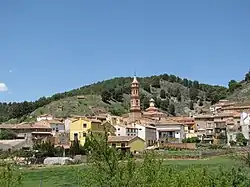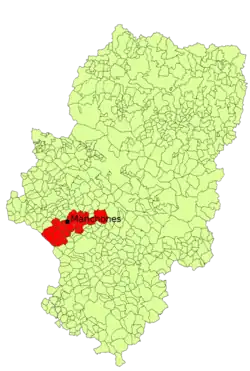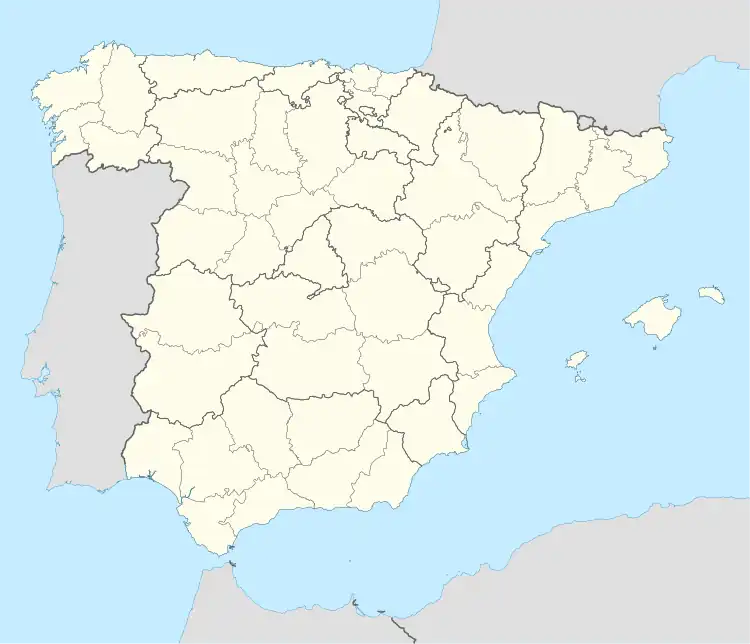Manchones | |
|---|---|
Municipality and village | |
 view of Manchones from the south | |
 Flag  Seal | |
 Location of Machones within Campo de Daroca in Aragon | |
 Manchones Location in Spain | |
| Coordinates: 41°09′N 1°28′W / 41.150°N 1.467°W | |
| Country | Spain |
| Autonomous community | Aragon |
| Province | Zaragoza |
| Comarca | Campo de Daroca |
| Government | |
| • Alcade | Jesús Pardillos Julián |
| Area | |
| • Total | 27 km2 (10 sq mi) |
| Elevation | 756 m (2,480 ft) |
| Population (2018)[2] | |
| • Total | 98 |
| • Density | 3.6/km2 (9.4/sq mi) |
| [3] | |
| Time zone | UTC+1 (CET) |
| • Summer (DST) | UTC+2 (CEST) |
| Postcode | 50366 |
| Area code | 976 |
Manchones is a municipality in the province of Zaragoza, Aragon, Spain. According to the Spanish Statistical Institute (INE), the municipality had a population of 123 inhabitants in 2010.[3] The pueblo is in the comarca of Campo de Daroca, about 6 kilometres (3.7 mi) northwest of Daroca and just southeast of Murero in the Calatayud-Daroca depression. The Jiloca River passes to the west.
The parish church is dedicated to the Conversion of St Paul. There are some remnants of defensive walls from the time of the Reconquista, when Alfonso the Battler, king of Aragon, forced a route through towards Valencia from Zaragoza.
Situation
Manchones is a small settlement situated at the base of a hill in the valley of the river Jiloca, between Calatayud and Daroca.[4] The pueblo lies on an ancient route between the Meseta Central, the Ebro and the coast of the Levante, which was certainly established in Roman times.[5]
History
Prehistoric remains have been found in the area and there is some evidence of Celtiberian settlement in Manchones. It has been suggested that the name of the pueblo derives from mancusos, gold coins in circulation in Aragon during the 11th century.[4]
Diego López de Lobera, who served under Alfonso the Battler during the Reconquista, was given the castle of Manchones in 1152.[6] In 1248, by grant from Jaime I of Aragon, Manchones was freed from its dependence on Daroca, becoming part of the Community of Daroca Villages, which was dissolved in 1838.[7]
Fiestas
The festivities in honour of St. Vincent and St. Paul are held in the last weekend of January, coinciding with the feast of St. Valero in Zaragoza, while those in honour of San Roque usually last five days, ending with the feast of the saint on 16 August. On August 15 they celebrate with a pilgrimage and a feast in the town square.[1]
Buildings
The parish church of the Conversion of St Paul was built in the eighteenth century on the site of a medieval church and was restored in 2004–2005.[8] Its chapel is dedicated to the Virgen del Pilar which contains a late 17th-century baroque reredos.[9] A 15th century wooden crucifix is housed in the sacristy.[10]
Surviving remains of defensive walls and towers indicate that Manchones was part of the defensive system for Daroca.[7]
Famous residents
References
- 1 2 3 "Manchones". Comarca del Campo de Daroca. 2011. Retrieved 15 June 2011.
- ↑ Municipal Register of Spain 2018. National Statistics Institute.
- 1 2 "Manchones, Zaragoza". Instituto Nacional de Estadística. (Spanish Statistical Institute). 2011. Retrieved 15 June 2011.
- 1 2 "Camino del Cid: Manchones". caminodelcid.org (in Spanish). 2011. Retrieved 15 June 2011.
- ↑ Domínguez, José Antonio; Berné, Luis Bolea. "Río Jiloca" (in Spanish). Centro de Cálculo de la Universidad de Zaragoza. Retrieved 15 June 2011.
- ↑ Crespo Vicente, Pascual (2007). "El baile procesional de Munébrega en honor de San Cristóbal. El Ton de San Cristóbal" (PDF). Cuadernos (in Spanish). 20: 53. ISSN 1136-8209. Retrieved 15 June 2011.
- 1 2 Corral Lafuente, José Luis (2007). "Daroca y su Comunidad" (PDF). Comarca de Daroca (in Spanish). Archived from the original (PDF) on 6 September 2011. Retrieved 15 June 2011.
- ↑ "Manchones". xiloca.com (in Spanish). 2011. Retrieved 15 June 2011.
Manchones tiene una hermosa Iglesia Parroquial dedicada a La conversion de San Pablo finalizada su restauración entre los años 2004 y 2005. La base es de tapial con filas de ladrillo, planta de cruz latina con tres naves separadas por pilastras cruciformes de orden corintio y cabecera plana. Sus bóvedas de luneta y en el crucero cupula octogonal sobre pechinas de tambor y linterna. Su retablo mayor es de madera sin policromar y con escenas de la vida de San Pablo. Fue edificada en el siglo XVII sobre los restos de la primitiva iglesia medieval, y fue reformadad en el siglo XVIII. La torre tiene tres cuerpos y fue edificada a partir de 1776 por Alejandro Sanz, maestro de obras de Daroca.
- ↑ "Manchones – Comarca de Campo de Daroca". Turismo en Aragón - RedAragon.com (in Spanish). 2011. Retrieved 15 June 2011.
Villa de la provincia de Zaragoza situada en la depresión Calatayud-Daroca, cercana al río Jiloca. Su iglesia parroquial es de dimensiones considerables, dedicada a la Conversión de San Pablo y construida en fábrica de ladrillo y tapial. Torre de tres cuerpos a los pies del edificio rematada en chapitel de pirámide. Existe además una ermita dedicada a la Virgen del Pilar que guarda en su interior un retablo barroco de finales del siglo XVII.
- ↑ "Gótica" (PDF). Comarca de Campo de Daroca (in Spanish). 2009. Archived from the original (PDF) on 6 September 2011. Retrieved 15 June 2011.
- ↑ "Bernal Julián, Jesús Ángel". xiloca.com (in Spanish). 2011. Retrieved 15 June 2011.
Bernal Julián, Jesús Ángel
- ↑ Staff (27 April 2008). "Toreros aragoneses - Página de voz - Gran Enciclopedia Aragonesa OnLine". Gran Enciclopedia Aragonesa OnLine (in Spanish). DiCom Medios SL. Retrieved 25 June 2011.
- ↑ Staff (30 November 1984). "Los seis candidatos". ELPAÍS.com (in Spanish). Retrieved 25 June 2011.